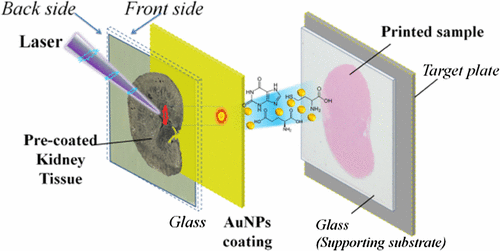Our official English website, www.x-mol.net, welcomes your feedback! (Note: you will need to create a separate account there.)
Chemical Printing of Biological Tissue by Gold Nanoparticle-Assisted Laser Ablation
ACS Omega ( IF 4.1 ) Pub Date : 2017-09-21 00:00:00 , DOI: 10.1021/acsomega.7b00385 Siu-Leung Chau 1 , Ho-Wai Tang 1 , Yu-Hong Cheng 1 , Chun-Nam Lok 1 , Kwan-Ming Ng 1
ACS Omega ( IF 4.1 ) Pub Date : 2017-09-21 00:00:00 , DOI: 10.1021/acsomega.7b00385 Siu-Leung Chau 1 , Ho-Wai Tang 1 , Yu-Hong Cheng 1 , Chun-Nam Lok 1 , Kwan-Ming Ng 1
Affiliation

|
A chemical printing method based on gold nanoparticle (AuNP)-assisted laser ablation has been developed. By rastering a thin layer of AuNPs coated on a rat kidney tissue section with a UV laser, biomolecules are extracted and immediately transferred/printed onto a supporting glass substrate. The integrity of the printed sample is preserved, as revealed by imaging mass spectrometric analysis. By studying the mechanism of the extraction/printing process, transiently molten AuNPs were found to be involved in the process, as supported by the color and morphological changes of the AuNP thin film. The success of this molecular printing method was based on the efficient laser–nanomaterial interaction, that is, the strong photoabsorption, laser-induced heating, and phase-transition properties of the AuNPs. It is anticipated that the molecular printing method can be applied to perform site-specific printing, which extracts and transfers biochemicals from different regions of biological tissue sections to different types of supporting materials for subsequent biochemical analysis with the preservation of the original tissue samples.
中文翻译:

金纳米粒子辅助激光烧蚀对生物组织的化学印刷
已经开发了一种基于金纳米粒子(AuNP)辅助激光烧蚀的化学印刷方法。通过用紫外线激光光栅化覆盖在大鼠肾脏组织切片上的AuNPs薄层,可以提取生物分子,并立即将其转移/印刷到支撑玻璃基板上。如成像质谱分析所揭示的,保留了打印样品的完整性。通过研究萃取/印刷过程的机理,发现瞬时熔融的AuNPs参与了该过程,并得到了AuNP薄膜的颜色和形态变化的支持。这种分子印刷方法的成功是基于有效的激光-纳米材料相互作用,即AuNPs的强光吸收,激光诱导的加热和相变特性。
更新日期:2017-09-21
中文翻译:

金纳米粒子辅助激光烧蚀对生物组织的化学印刷
已经开发了一种基于金纳米粒子(AuNP)辅助激光烧蚀的化学印刷方法。通过用紫外线激光光栅化覆盖在大鼠肾脏组织切片上的AuNPs薄层,可以提取生物分子,并立即将其转移/印刷到支撑玻璃基板上。如成像质谱分析所揭示的,保留了打印样品的完整性。通过研究萃取/印刷过程的机理,发现瞬时熔融的AuNPs参与了该过程,并得到了AuNP薄膜的颜色和形态变化的支持。这种分子印刷方法的成功是基于有效的激光-纳米材料相互作用,即AuNPs的强光吸收,激光诱导的加热和相变特性。



























 京公网安备 11010802027423号
京公网安备 11010802027423号